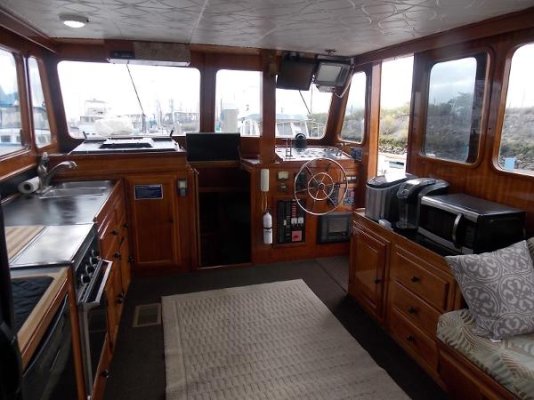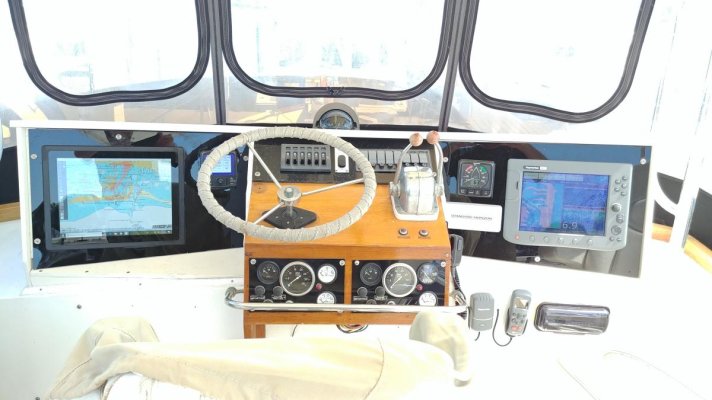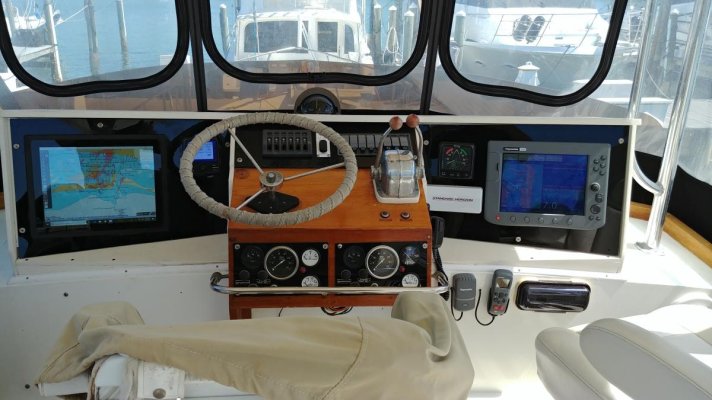STB
Guru
Hi all,
Many thanks to the forum users who helped me get organized for my most recent trip to the boat. I did (mostly) complete the planned electronics upgrade and integration, but there are a couple of minor loose ends. This note is just an update for anyone it might help.
Recall that the "end game" was to integrate what I had, and add in a Simrad 4G radar and OpenCPN-based plotter, as well as support for a Wi-Fi tablet to run OpenCPN (mostly as a toy). A second OpenCPN PC is planned for the lower helm.
My new-to-me boat came equipped as follows:
-- Raymarine (RM) C120 Classic 12" display + RM GPS
-- RM DSM-300 + B744V Depth+Temp+Speed
-- RM Z195 Rotavecta Wind transducer
-- ACU-200 + p70r control head + rudder indicator + wireless smart controller autopilot
I added the following:
-- Standard Horizon GX2200 internal AIS+GPS VHF radio
-- EM-Trak A100 Class A AIS transciever
-- Simrad 4G radar + RI10 interface
-- Modpul Miniplex-3Wi-N2K NMEA-0183/NMEA-2000-WiFi-SeaTalk bridge
-- Netgear AC-100 switch/wi-fi router
-- Lenovo 610s mini-pc
-- Xenarc 1029GNH outdoor touchscreen display
-- Raymarine i70 wind display
-- USB GPS antenna
Shortly I'll add a 2nd permanant hard-wired unit for the lower helm, but I need to add controls to the lower helm first. They were apparently never connected in the boat.
The "main" data bus in the boat is the Raymarine SeaTalk-NG. It is natively connected to the autopilot, control head, rudder sensor, EV-1 sensor core, and wind display.
The C120, GPS antenna, and wireless autopilot smart controller are SeaTalk-1. They are connected as a stub to the Seatalk-NG bus via a Raymarine SeaTalk-1:SeatalkNG bridge.
The Simrad 4G radar connects to the RI10 interface box that box, in turn, connects to both an ethernet port on the back of the WiFi router and also to the SeaTalk-NG bus. Ethernet cables were made according to the OpenCPN BR24 Radar Plug-In manual. The SimNet output from the RI10 was connected to the Seatalk_NG bus using a store-bought converter cable.
The AIS transciever gets various input data via NMEA-0183. The VHF radio puts out AIS, DSC, and GPS data via NMEA-0183.
The Seatalk-1, SeaTalk-NG, NMEA-0183 and NMEA 2000 came together at the MiniPlex-3Wi-N2K bridge, which alsobridged the data to a USB port for the PC and to Wi-Fi. The WiFi interface was made a DHCP client of the Netgear AC1200.
For convenience, I used the AIS output from the VHF radio to feed the network, but sent various data back from the network to the AIS transceiver so it could send it out with the dynamic data.
In the end, "everything" basically worked. The data is exchanged across the whole system. The fixed OpenCPN plotter up top can display 2-ranges of radar, one overlayed onto the charts as well as any of the AIS data as virtual instruments. The tablet gets the radard data and AIS data via Wi-Fi and can do the same. It all works really nicely.
The old C120 Classic is reduced to a full-time fishfinder and backup plotter.
There are, of course, a small few exceptions:
-- I have four sources of GPS data. I haven't yet set up the routing to know how OpenCPN is managing the multiple data sources: EV-1, VHF radio, C120's GPS, cheap USB GPS plugged into plotter. I really should know the answer to this. What I do know is that I can unplug them until I just have one and OpenCPN works.
-- Although I'm getting GPS location data from multiple sources floating around, the satellite status information doesn't seem to be making it through to the wireless unit. I haven't investigated. I just know it is showing up on OpenCPN's dashboard only on the one host that has the USB GPS unit locally.
-- I got the Lenovo 610s because it seemed to be compatible with Lenovo's DC laptop power adapter. But, although they use the same rectangular connector, that doesn't seem to be the case. It rejected the "Brand X" Lenovo adapter I bought for it, complaining that it wasn't powerful enough. I ended up putting a point-of-use inverter on it while ordering a DC-DC 12V->20V boost converter that I hope will become the permanent answer. We'll see how that works when I get it.
When I add the lower unit in a few weeks, I plan to attach it to the SeatalkNG network via an ActiSense NGT-1 and also up to one of the Wi-Fi routers's hard ethernet ports for radar. I'll probably also give it one of the BrandX USB GPS units for redundancy. I'll probably use a Elo 1515L touch panel for the display, as I did in my last boat.
But, for right now, I have a weatherproof, touch, daylight visible 10" OpenCPN panel up top as well as a Wi-Fi OpenCPN tablet. Both integrate Radar with dual-range, MARPA, etc as well as all of the AIS stuff and autopilot. All the data (NMEA-0183, NMEA-2000, Seatalk-1, SeaTalk-NG, and SimNet is all bridges together, and delivered by Wi-Fi and USB.
Attached are a couple of pictures, one of the fixed unit and the other from the Wi-Fi laptop. They are running simultaneously. Notice the two different radar ranges, a Simrad 4G feature supported by the OpenCPN BR24 radar plug in. The two photos show different subsets of the sensor data displayed as virtual instruments, just because of what I'd selected.
Cheers -- and thanks for all your help a few weeks back.
-Greg
Many thanks to the forum users who helped me get organized for my most recent trip to the boat. I did (mostly) complete the planned electronics upgrade and integration, but there are a couple of minor loose ends. This note is just an update for anyone it might help.
Recall that the "end game" was to integrate what I had, and add in a Simrad 4G radar and OpenCPN-based plotter, as well as support for a Wi-Fi tablet to run OpenCPN (mostly as a toy). A second OpenCPN PC is planned for the lower helm.
My new-to-me boat came equipped as follows:
-- Raymarine (RM) C120 Classic 12" display + RM GPS
-- RM DSM-300 + B744V Depth+Temp+Speed
-- RM Z195 Rotavecta Wind transducer
-- ACU-200 + p70r control head + rudder indicator + wireless smart controller autopilot
I added the following:
-- Standard Horizon GX2200 internal AIS+GPS VHF radio
-- EM-Trak A100 Class A AIS transciever
-- Simrad 4G radar + RI10 interface
-- Modpul Miniplex-3Wi-N2K NMEA-0183/NMEA-2000-WiFi-SeaTalk bridge
-- Netgear AC-100 switch/wi-fi router
-- Lenovo 610s mini-pc
-- Xenarc 1029GNH outdoor touchscreen display
-- Raymarine i70 wind display
-- USB GPS antenna
Shortly I'll add a 2nd permanant hard-wired unit for the lower helm, but I need to add controls to the lower helm first. They were apparently never connected in the boat.
The "main" data bus in the boat is the Raymarine SeaTalk-NG. It is natively connected to the autopilot, control head, rudder sensor, EV-1 sensor core, and wind display.
The C120, GPS antenna, and wireless autopilot smart controller are SeaTalk-1. They are connected as a stub to the Seatalk-NG bus via a Raymarine SeaTalk-1:SeatalkNG bridge.
The Simrad 4G radar connects to the RI10 interface box that box, in turn, connects to both an ethernet port on the back of the WiFi router and also to the SeaTalk-NG bus. Ethernet cables were made according to the OpenCPN BR24 Radar Plug-In manual. The SimNet output from the RI10 was connected to the Seatalk_NG bus using a store-bought converter cable.
The AIS transciever gets various input data via NMEA-0183. The VHF radio puts out AIS, DSC, and GPS data via NMEA-0183.
The Seatalk-1, SeaTalk-NG, NMEA-0183 and NMEA 2000 came together at the MiniPlex-3Wi-N2K bridge, which alsobridged the data to a USB port for the PC and to Wi-Fi. The WiFi interface was made a DHCP client of the Netgear AC1200.
For convenience, I used the AIS output from the VHF radio to feed the network, but sent various data back from the network to the AIS transceiver so it could send it out with the dynamic data.
In the end, "everything" basically worked. The data is exchanged across the whole system. The fixed OpenCPN plotter up top can display 2-ranges of radar, one overlayed onto the charts as well as any of the AIS data as virtual instruments. The tablet gets the radard data and AIS data via Wi-Fi and can do the same. It all works really nicely.
The old C120 Classic is reduced to a full-time fishfinder and backup plotter.
There are, of course, a small few exceptions:
-- I have four sources of GPS data. I haven't yet set up the routing to know how OpenCPN is managing the multiple data sources: EV-1, VHF radio, C120's GPS, cheap USB GPS plugged into plotter. I really should know the answer to this. What I do know is that I can unplug them until I just have one and OpenCPN works.
-- Although I'm getting GPS location data from multiple sources floating around, the satellite status information doesn't seem to be making it through to the wireless unit. I haven't investigated. I just know it is showing up on OpenCPN's dashboard only on the one host that has the USB GPS unit locally.
-- I got the Lenovo 610s because it seemed to be compatible with Lenovo's DC laptop power adapter. But, although they use the same rectangular connector, that doesn't seem to be the case. It rejected the "Brand X" Lenovo adapter I bought for it, complaining that it wasn't powerful enough. I ended up putting a point-of-use inverter on it while ordering a DC-DC 12V->20V boost converter that I hope will become the permanent answer. We'll see how that works when I get it.
When I add the lower unit in a few weeks, I plan to attach it to the SeatalkNG network via an ActiSense NGT-1 and also up to one of the Wi-Fi routers's hard ethernet ports for radar. I'll probably also give it one of the BrandX USB GPS units for redundancy. I'll probably use a Elo 1515L touch panel for the display, as I did in my last boat.
But, for right now, I have a weatherproof, touch, daylight visible 10" OpenCPN panel up top as well as a Wi-Fi OpenCPN tablet. Both integrate Radar with dual-range, MARPA, etc as well as all of the AIS stuff and autopilot. All the data (NMEA-0183, NMEA-2000, Seatalk-1, SeaTalk-NG, and SimNet is all bridges together, and delivered by Wi-Fi and USB.
Attached are a couple of pictures, one of the fixed unit and the other from the Wi-Fi laptop. They are running simultaneously. Notice the two different radar ranges, a Simrad 4G feature supported by the OpenCPN BR24 radar plug in. The two photos show different subsets of the sensor data displayed as virtual instruments, just because of what I'd selected.
Cheers -- and thanks for all your help a few weeks back.
-Greg







